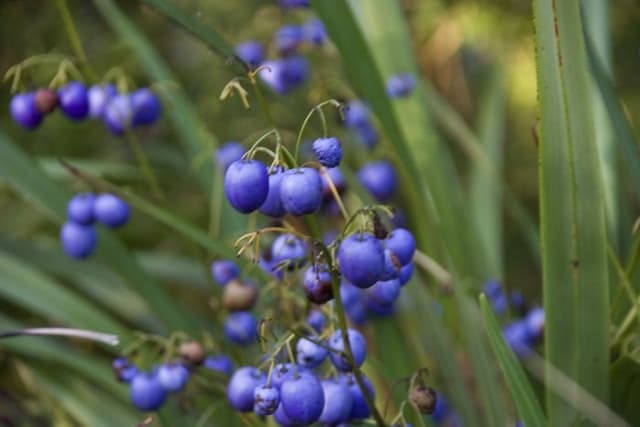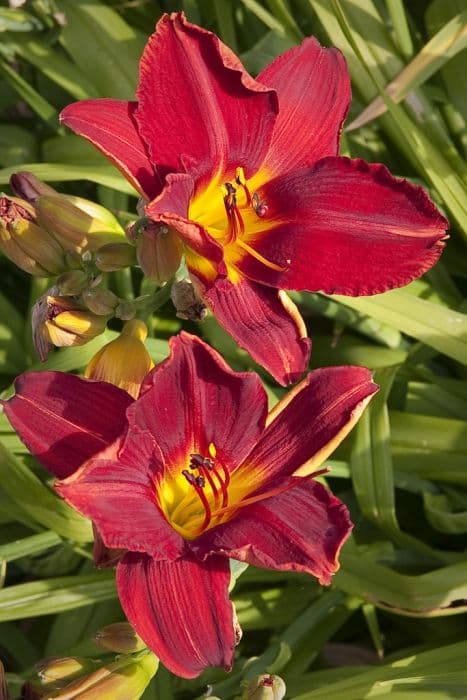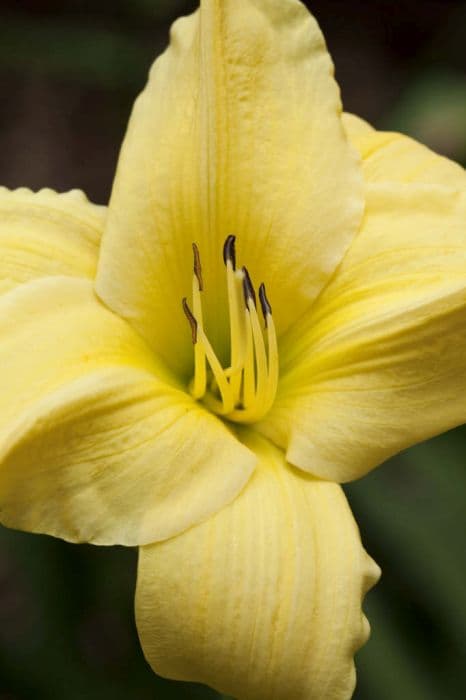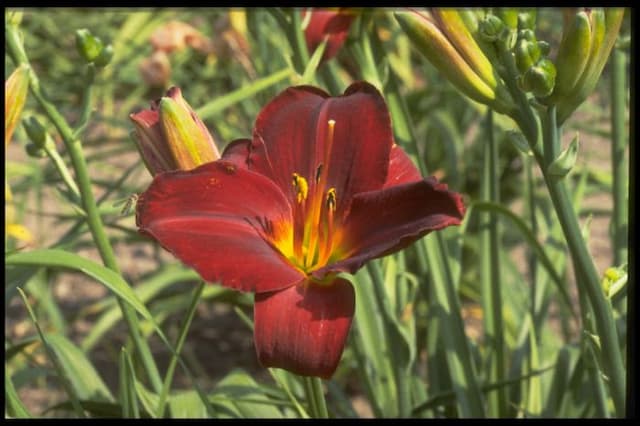Stella de Oro daylily Hemerocallis 'Stella de Oro'

ABOUT
The 'Stella de Oro' daylily is a charming perennial that is renowned for its vibrant and abundant blooms. Its flowers are trumpet-shaped with a rich, golden-yellow hue that exudes warmth and brightness in any garden space. These blooms typically feature ruffled edges and a slightly recurved shape that adds to their visual appeal. The flowers are arrayed gracefully on slender stalks that emerge from clumps of long, strappy leaves. The foliage is a lush, green color, with a grass-like texture that forms a dense and arching mound. The leaves provide a lovely contrast to the joyful yellow of the flowers. This daylily's blooms last for just one day, but they are produced in large numbers over a lengthy blooming period, ensuring a continuous display of color throughout the season. Additionally, 'Stella de Oro' is known for its ability to rebloom, offering multiple flushes of flowers in the right conditions. This plant's overall appearance conveys a sense of hardiness, ease of care, and long-lasting charm, making it a favorite choice for gardeners seeking to add a splash of enduring color to their landscapes.
About this plant
 Names
NamesFamily
Hemerocallidaceae
Synonyms
Stella de Oro Daylily, Yellow Daylily, Dwarf Daylily
Common names
Hemerocallis 'Stella de Oro'.
 Toxicity
ToxicityTo humans
Daylily (Hemerocallis 'Stella de Oro') is generally considered non-toxic to humans, and in fact, certain parts of the plant are edible when prepared properly. However, sensitivity varies from person to person, and any part of the plant, if ingested in large quantities, could potentially cause mild stomach upset, nausea, or diarrhea due to the presence of unknown or unrecognized compounds that may not agree with everyone. It’s also important to note that eating non-culinary plants can pose a risk due to potential contamination with pesticides or other chemicals.
To pets
Daylily is known to be highly toxic to cats, even in small amounts. If a cat ingests any part of a daylily plant, it could lead to severe kidney damage, which can be fatal. Symptoms of daylily poisoning in cats may include vomiting, lethargy, kidney failure, and lack of appetite. If you suspect your cat has ingested daylily, seek immediate veterinary care. Dogs are generally less sensitive, but ingestion could still potentially lead to mild gastrointestinal upset. To be safe, keep all pets away from daylilies.
 Characteristics
CharacteristicsLife cycle
Perennials
Foliage type
Deciduous
Color of leaves
Green
Flower color
Yellow
Height
1 feet 18 inches [45 cm]
Spread
1 feet 18 inches [45 cm]
Plant type
Herb
Hardiness zones
3-9
Native area
Asia
Benefits
 General Benefits
General Benefits- Easy to Grow: The plant is known for its hardiness and adaptability to a variety of growing conditions.
- Continuous Blooming: Stella de Oro daylily blooms repeatedly throughout the growing season, providing long-lasting color.
- Drought Tolerant: Once established, it requires minimal watering, making it a suitable choice for water-wise gardens.
- Low Maintenance: It requires little care beyond removing spent blooms and occasional division to stimulate growth.
- Landscape Versatility: Used in borders, as ground cover, or in container gardening, adding versatility to garden designs.
- Attracts Pollinators: The vibrant flowers attract butterflies and other beneficial pollinators to the garden.
- Compact Size: Its small size makes it suitable for gardens with limited space and for use as a border plant.
 Medical Properties
Medical PropertiesThis plant is not used for medical purposes.
 Air-purifying Qualities
Air-purifying QualitiesThis plant is not specifically known for air purifying qualities.
 Other Uses
Other Uses- Edible Flowers: The blooms of the Stella de Oro daylily can be consumed in salads or used as an edible garnish due to their mild, slightly sweet taste.
- Companion Planting: It can serve as a companion plant in vegetable gardens to help disguise crops from pests or to attract pollinators.
- Plant Dye: The petals of the Stella de Oro can be used to create a natural yellow-orange dye for fabrics or crafts.
- Drought Tolerant Ground Cover: They can act as an effective ground cover in dry, arid conditions, helping to reduce soil erosion.
- Creative Crafts: The dried flowers of the Stella de Oro can be incorporated into potpourri or used in creative dried flower arrangements.
- Erosion Control: Their extensive root system can help stabilize slopes and areas prone to erosion.
- Photography: This plant is popular among photographers for its vibrant color and durability, making it an ideal subject for garden and nature photography.
- Education: Stella de Oro daylilies are often used in educational settings to teach about plant biology, propagation, and horticulture due to their hardiness and ease of care.
- Border Plant: They work well as border plants in landscaping designs, providing long periods of color with minimal maintenance.
- Water Garden Accent: While not an aquatic plant, Stella de Oro can be used around water features to provide color and contrast.
Interesting Facts
 Feng Shui
Feng ShuiDaylily is not used in Feng Shui practice.
 Zodiac Sign Compitability
Zodiac Sign CompitabilityDaylily is not used in astrology practice.
 Plant Symbolism
Plant Symbolism- Longevity: The scientific name Hemerocallis comes from the Greek words "hemera" meaning "day" and "kallos" meaning "beauty," referring to the flower's individual blooms that typically last only a day. 'Stella de Oro', being a daylily, symbolizes the fleeting nature of life, reminding us to cherish each moment.
- Motherhood: In Chinese culture, daylilies are often associated with motherhood and feminine qualities due to their nurturing and caring nature of producing numerous blooms over a prolonged period.
- Renewal: As a daylily, 'Stella de Oro' represents renewal and the start of a new day. Each bloom starts afresh, symbolizing hope and new beginnings.
- Forgetfulness of Worries: Daylilies can symbolize leaving behind one's worries or troubles. The blooming cycle suggests the idea of letting go of yesterday's concerns and moving forward.
- Fertility: With its vigorous growth and abundant flowering, 'Stella de Oro' can symbolize fertility and creativity, reflecting an ability to produce life and ideas generously.
 Water
WaterDaylilies, specifically the 'Stella de Oro', require consistent moisture, especially during their active growing season in the spring and summer. It's best to water them deeply once a week, providing about an inch of water each time. During hot and dry periods, you may need to water them more frequently to maintain moisture in the soil. Use a soaker hose or drip irrigation to deliver water directly to the roots and minimize leaf wetness, which can lead to fungal diseases. Each watering session should involve around 1 to 1.5 gallons of water for each plant to ensure the soil is moistened to a depth of at least 8 inches.
 Light
LightThe 'Stella de Oro' daylily thrives in full sun to partial shade conditions. It will bloom most prolifically with at least six hours of direct sunlight per day. A spot that receives morning sun and afternoon shade is ideal, especially in hotter climates, to protect it from the intense midday heat which can stress the plant.
 Temperature
Temperature'Stella de Oro' daylilies are hardy and can tolerate a wide range of temperatures, from as low as -20°F to as high as 90°F. However, they grow best when daytime temperatures are between 60°F and 80°F. Ensure the plant is mulched to protect its roots from temperature extremes, particularly in very cold or very hot weather.
 Pruning
PruningPrune 'Stella de Oro' daylilies to remove spent flower stalks and encourage reblooming, as well as to maintain plant health and appearance. The best time to prune is immediately after a bloom cycle, when flower stalks begin to wither. Cutting these back to the base of the plant will stimulate new growth. Additionally, remove any dead or damaged foliage as needed throughout the growing season to keep the plant tidy.
 Cleaning
CleaningAs needed
 Soil
SoilDaylilies, commonly known as 'Stella de Oro', thrive in well-draining, fertile soil with a pH ranging from 6.0 to 6.5. A good soil mix for daylilies would be a blend of loam, compost, and sand or perlite to ensure proper drainage. Regular amendment with organic matter helps maintain fertility and soil structure.
 Repotting
RepottingDaylilies like 'Stella de Oro' rarely need repotting since they are typically grown outdoors in the ground. However, if grown in containers, they should be repotted every 3 to 4 years to refresh the soil and divide the clumps if overcrowded.
 Humidity & Misting
Humidity & Misting'Stella de Oro' daylilies are not particularly humidity-sensitive and do well in average outdoor humidity levels. They are quite adaptable and can thrive in a range of humidity conditions provided that their soil moisture needs are met.
 Suitable locations
Suitable locationsIndoor
Provide bright light and well-draining soil for indoor 'Stella de Oro'.
Outdoor
Plant in sun to partial shade in well-draining soil for 'Stella de Oro'.
Hardiness zone
3-9 USDA
 Life cycle
Life cycleDaylily 'Stella de Oro' begins its life cycle as a dormant clump of roots, or as a seed, if conditions allow for sexual reproduction. Upon the arrival of favorable conditions, typically in spring, the plant breaks dormancy and shoots emerge from the rootstock, developing into long, strap-like leaves. The vegetative growth phase continues with the formation of flower scapes which carry multiple buds that will bloom. Following the vegetative stage, the reproductive phase commences with the blooming of the golden yellow flowers, which generally only last for one day, hence the common name "daylily." After pollination, if it occurs, the flowers will develop into three-chambered seed pods containing numerous black seeds, completing the sexual cycle. In the absence of pollination, or in the fall, the plant enters a period of senescence, with foliage dying back as the plant returns to dormancy, ready to repeat the cycle the next season.
 Propogation
PropogationPropogation time
Early spring
The most popular method of propagating the Daylily 'Stella de Oro' is through division, which is best done in early spring or late summer to early fall. This process involves digging up the entire clump of the plant once it has matured and has several fans of leaves. Using a sharp spade or knife, the clump is carefully separated into smaller sections, making sure that each section has at least two to three fans of leaves along with a portion of the root system. The divisions should then be replanted at the same depth they were originally growing, spaced about 18 to 24 inches apart to allow room for growth. Watering the divisions thoroughly after planting helps establish them in their new location.









